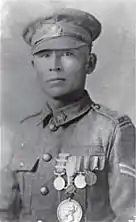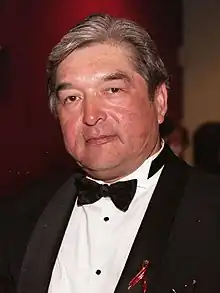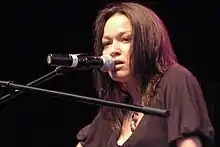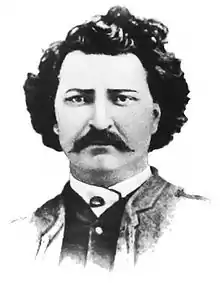| Indigenous peoples in Canada |
|---|
.JPG.webp) |
|
|
Over the course of centuries, many Indigenous Canadians have played a critical role in shaping the history of Canada. From art and music, to law and government, to sports and war; Indigenous customs and culture have had a strong influences on defining Canadian culture.[1][2][3] The Indspire Awards are the annual awards presented by Indspire, formerly the National Aboriginal Achievement Foundation.[4] The awards were first established in 1993 in conjunction with the United Nations declaring the 1990s "International Decade of the World's Indigenous peoples".[5] June 21 is Canada's National Aboriginal Day, in recognition of the cultural contributions made by Canada's indigenous population. The day was first celebrated in 1996 following Governor General of Canada Roméo LeBlanc's proclamation.[6]
1,172,790 million people reported having at least some Indigenous ancestry in 2006, representing 3.8% of the total Canadian population.[7] From 1981 to 2001, the percentage of Indigenous people who obtained college diplomas increased from 15.0 per cent to 22.0 per cent, while the percentage that obtained university degrees increased from 4.0 per cent to 6.0 per cent.[7] This compares with increases of 20.0 per cent to 25.0 per cent for non-Indigenous people obtaining college diplomas that is a narrow gap between the Indigenous and non-Indigenous population.[7] This is partly due to organizations that focus attention on the achievements and welfare of Indigenous Canadians like, Congress of Aboriginal Peoples, Native Women's Association of Canada, Aboriginal Curatorial Collective, National Aboriginal Health Organization, Metis Child and Family Services Society and Aboriginal Peoples Television Network.
Notable individuals
First Nations
First Nation people have come from a diverse background of history, economy, culture, and government. First Nations become active politicians in the Canadian government holding a sense of pride and patriotism towards the nation of Canada. First Nations also become politicians within their own well-defined First Nation government known as the Assembly of First Nations (AFN) which supported by its membership, land base and tribal councils[8]

Shanawdithit, born 1801, was the last recorded surviving member of the Beothuk people.[9][10] After Shanawdithit's death in 1829, the Beothuk people became officially extinct as a separate ethnic group.[11] Aatsista-Mahkan (Running Rabbit), became chief of the Siksika First Nation following the death of his father in 1871.[12] Aatsista-Mahkan was a signatory to Treaty 7, but he and his people continued living the plains Indian lifestyle following the bison until 1881.[12] The Siksika Nation was then forced to settle on a reserve 60 miles (97 km) east of today's Calgary, Alberta.[13] Big Bear (mistahi-maskwa) was a Cree leader notable for his participation in the 1870 Battle of the Belly River. Following this, in 1873, Big Bear clashed with the Métis.[13] Francis Pegahmagabow was the First Nation soldier most highly decorated for bravery in Canadian military history and the most effective sniper of World War I.[14] Mary Greyeyes-Reid was the first First Nations woman to join the Canadian Forces.[15] Tommy Prince was one of Canada's most decorated First Nations soldiers, serving in World War II and the Korean War.[16] Mary John, Sr., CM was a leader of the Dakelh (Carrier) people and a social activist.[17] A story of her life is told in the book titled Stoney Creek Woman.[18] Ethel Blondin-Andrew, was a Canadian politician of Dene descent in the Northwest Territories and the first Indigenous woman to be elected to the Parliament of Canada.[19] Ovide Mercredi is a politician of Cree descent and a former national chief of the Assembly of First Nations.[20] Harold Cardinal was a Cree writer, political leader, teacher, negotiator and lawyer who demanded, on behalf of all First Nation peoples, the right to be "the red tile in the Canadian mosaic.[21] Skowkale lawyer and judge, Steven Point, OBC (Xwĕ lī qwĕl tĕl), was the Lieutenant Governor of British Columbia from 2007 to 2012.[22] Harriet Nahanee was a civil rights activist, a Canadian residential school system survivor and environmentalist.[23] Nahanee was arrested and imprisoned in 2007 at the age of 71 for trying to protect Squamish Nation territory.[23] Theresa Spence a chief of the Attawapiskat First Nation is a prominent figure in the modern Attawapiskat housing and infrastructure crisis and Idle No More protest.[24][25]

The arts and entertainment industry has seen Indigenous peoples stand at the Oscars, an internationally prominent award ceremony such as Chief Dan George.[26] Dan George OC, was chief of the Tsleil-Waututh (Coast Salish) Nation, Academy Award-nominated actor and an author.[26] Adam Beach is an actor of Saulteaux descent from Dog Creek First Nations Reserve at Lake Manitoba.[27] Beach has acted in high-profile roles such as, Marine Private First Class Ira Hayes in Flags of Our Fathers, Private Ben Yahzee in Windtalkers, Chester Lake in Law & Order: Special Victims Unit and starred in Canadian television productions such as Arctic Air.[28] Lorne Cardinal of Cree descent, is noted for playing First Nations roles in many productions.[29] Cardinal most notable Canadian role was portraying character Davis Quinton on the Canadian television series Corner Gas.[29] Tantoo Cardinal is a Canadian film and television actress of Métis and Cree descent.[30]Graham Greene is an Academy Award–nominated Canadian actor from the Oneida tribe.[31] He was born in Ohsweken on the Six Nations Reserve in Ontario.[31]
Shania Twain is a country pop artist of partial Cree ancestry.[32] Shania Twain along with Alanis Morissette are the only Canadian musicians to have sold over 2 million units in Canada, receiving the double diamond award.[33] Kashtin was a Canadian folk rock duo composed of Innu Claude McKenzie and Florent Vollant.[34] Robbie Robertson, Mohawk, musician, singer–songwriter, and guitarist is best known for his membership in The Band.[35] Norval Morrisseau, CM, or Copper Thunderbird, was an Anishinaabe artist known as the "Picasso of the North".[36] Bill Reid, OBC, was an artist who renewed interest in his heritage Haida art, with his sculpture and totem poles.[37]
In sports there are number of accomplished First Nations peoples such as Tom Longboat an Onondaga distance runner.[38] Longboat was inducted into both Canada's Sports Hall of Fame and the Indian Hall of Fame.[38] George "Chief" Armstrong was noted as an Irish-Algonquin, professional hockey player.[39] Ted Nolan, Ojibwe, Jack Adams Award winner, is a retired professional hockey left winger of the National Hockey League (NHL).[40] Nolan was the former head coach and vice president of hockey operations for an American Hockey League (AHL) team.[40] Jonathan Cheechoo was the first member of the Moose Factory Cree Nation to play hockey for the Ottawa Senators of the NHL.[41][42] Of Cree heritage, Jon Mirasty, "Nasty Mirasty", is a popular enforcer in the AHL.[43]
Inuit
.jpg.webp)
Inuit serving in political roles have actively advocated in support of the Inuit community. Some Inuit serve within a national political organisation known as the Inuit Tapiriit Kanatami.[8] Abe Okpik CM, was instrumental in helping Inuit obtain surnames rather than disc numbers.[44] Simonie Michael, the first Inuk to be elected to what is now the Legislative Assembly of the Northwest Territories, was among the early Inuit leaders to call for an end to the disc numbers.[44] Kiviaq (David Ward) was the first Inuk to become a lawyer, and is responsible for several important advances in establishing the legal rights of the Inuit.[45] In 2001, Kiviaq won the legal right to use his single-word Inuktitut name.[46] Peter Irniq a former Commissioner of Nunavut set up the offices of "the Official Languages, Access to Information and Conflict of Interest Commissioners".[47] Irniq also has encouraged the use of the Inuit languages and the culture, referred to as Inuit Qaujimajatuqangit or IQ.[47] Sheila Watt-Cloutier, OC, is an Inuit political representative and activist at the regional, national and international levels.[48] Sheila has most recently worked as International Chair of the Inuit Circumpolar Council (formerly the Inuit Circumpolar Conference).[48] Nellie Cournoyea, OC, of Inupiat heritage, served as the first female Premier of the Northwest Territories and the second female leader of an elected legislature in Canada.[49] Helen Maksagak, CM, a Copper Inuit, was the last Commissioner of the undivided NWT and first Commissioner of Nunavut.[50] Paul Okalik was the first Premier of Nunavut whose "dream was to help his people in their dealings with the Canadian justice system."[51] Ann Meekitjuk Hanson is the Commissioner of Nunavut as well as civil servant, broadcaster, journalist, and author.[52]
Historically among the Inuit, Stephen Angulalik was an internationally known Ahiarmiut Inuit from northern Canada.[53] Angulalik was recognized as a Kitikmeot fur trader and trading post operator at Kuugjuaq (Perry River), NWT.[53] According to Royal Canadian Mounted Police Sergeant Henry Larsen by 1941, Angulalik and his third wife had raised 11 children.[54][55] Ebierbing, also known as "Eskimo Joe", was a guide and explorer.[56] Ebierbing was one of the most widely travelled Inuit in the 1860s and 1870s, he assisted Arctic explorers.[56] Peter Pitseolak was an Inuit photographer, artist and historian.[57] Pitseolak lived most of his life in traditional Inuit camps near Cape Dorset, on the southwest coast of Baffin Island, now in the Canadian territory of Nunavut.[57]

Kenojuak Ashevak, CC, is a noteworthy pioneer of modern Inuit art.[58] Born in an igloo in an Inuit camp in 1927, by the late 1950s Kenojuak became one of the first Inuit women in Cape Dorset to begin drawing.[58] She has since created many carvings from soapstone and thousands of drawings, etchings, stone-cuts, and prints – all sought after by museums and collectors.[58] Zacharias Kunuk, is a producer and director distinguished for his film Atanarjuat: The Fast Runner.[59] Atanarjuat was the first Canadian dramatic feature film produced completely in Inuktitut.[59] Atanarjuat is co-founder and president of Igloolik Isuma Productions, Canada's first independent Inuit production company.[59] Annabella Piugattuk is a throat singer, and actress memorable for her role in The Snow Walker.[60] Susan Aglukark is a three-time Juno winning musician, in 1995 for New Artist of the Year and Best Music of Aboriginal Canada.[61] In 2004 Susan won for Aboriginal Recording of the Year, with a blend of folk Inuit music, traditions with country and pop sounds.[61] Tanya Tagaq Gillis is an Inuit throat singer, who performs as a solo artist rather than part of a traditional duo.[62] Charlie Panigoniak is a country singer-songwriter and guitarist whose albums reflect on northern life.[63] Lucie Idlout is a rock singer who writes songs that called attention to the issue of domestic violence in Canada.[64] Jessie Oonark was an internationally renowned artist who was elected a Member of the Royal Canadian Academy of Arts and made an Officer of the Order of Canada.[65] Alootook Ipellie was an illustrator and writer who told the stories of the Inuit in print.[66] Natar Ungalaaq is an actor, filmmaker, and sculptor whose artwork is in many major Inuit art collections worldwide.[67] In sports, Jordin Tootoo is the first Inuk athlete to become a professional ice hockey player playing with the NHL.[68]
Métis

The life and times of celebrated Métis people include military figures, entrepreneurs, and sports professionals. Historically, William Kennedy was an Arctic explorer and, in 1851, commander of the second of four expeditions sponsored by Lady Franklin to find her husband, Sir John Franklin.[69] Gabriel Dumont brought Louis Riel back to Canada, in order to pressure the Canadian authorities to pay attention to the troubles of the Métis people. Louis Riel was a founder of the province of Manitoba, and leader of the Métis people of the Canadian Prairies.[70] He led two rebellions against the Canadian government and its first post-Confederation Prime Minister, Sir John A. Macdonald; the Red River Rebellion of 1869–1870[71] and the North-West Rebellion of 1885 which ended in his trial.[72] Dumont would serve under Riel as adjutant general in the provisional Métis government declared in Saskatchewan in 1885. Dumont then commanded the Métis forces in the North-West Rebellion. Elzéar Goulet was a Métis leader in the Red River Settlement, supporter of Louis Riel's provisional government and namesake of Winnipeg's Elzéar Goulet Memorial Park.[73] Charles Nolin was a Métis farmer and active political organiser who equivocated between religion and political support of the North-West Rebellion and his first cousin Louis Riel.[74][75] John Bruce was the first president of the Métis provisional government and fought at the Red River Settlement during the Red River Rebellion of 1869.[76]
The Métis National Council is a national political organisation supported with provincial associations and local communities.[8] Activists for the Métis community include Pearl Calahasen who was the first Métis woman elected to public office in Alberta and Associate Minister of Aboriginal Affairs.[77] Senator Thelma Chalifoux was the first female Métis to receive the National Aboriginal Achievement Award.[78][79]
Blanche Brillon Macdonald was an entrepreneur and activist who developed the "Blanche Macdonald Centre".[80] Suzanne Rochon-Burnett, CM, O.Ont was a businesswoman and a founder of the Métis Nation of Ontario.[81]

Métis traditional culture is portrayed in arts and entertainment by artists such as Christi Belcourt.[82] Belcourt, a painter, craftsperson, and writer, is preeminently known for her acrylic paintings that depict floral patterns.[82] These patterns are inspired by Métis and First Nations historical beadwork art.[82] Laura de Jonge is a family advocate, corporate social responsibility practitioner, filmmaker, and magazine founder.[83] George R. D. Goulet is a best-selling author whose works include several titles about the Métis.[84] Tom Jackson has starred in TV shows such as North of 60 and Shining Time Station.[85] Jackson has also released several albums of country and folk music.[85] Douglas Cardinal, OC, from Calgary is a renowned architect.[86] Born of Métis and Blackfoot heritage, Cardinal is famous for flowing architecture marked with smooth lines, influenced by his Indigenous heritage as well as European Expressionist architecture.[86]
Well known Métis sports figures include Bryan Trottier, a retired Canadian American professional ice hockey centre Hall of Fame award recipient who played 18 seasons in the NHL.[87] Wade Redden is a professional ice hockey NHL defenceman and an alternate captain.[88] Redden has won two Canadian gold medals in the World Junior Championships and once in the World Cup of Hockey.[88] Rene Bourque is a professional ice hockey player in the NHL and first cousin of North American Native Boxing Champion Wayne Bourque.[89] Wayne Bourque has been the North American Native boxing champion three times.[90]
See also
References
- ↑ "Culture Areas Index". Canadian Museum of Civilization. Archived from the original on October 20, 2009. Retrieved October 16, 2009.
- ↑ Newhouse, David. "Hidden in Plain Sight Aboriginal Contributions to Canada and Canadian Identity Creating a new Indian Problem" (PDF). Centre of Canadian Studies, University of Edinburgh. Archived from the original (PDF) on July 23, 2011. Retrieved October 17, 2009.
- ↑ "A VIRTUAL TOUR OF FIRST NATION CULTURE IN CANADA". Saskatchewan Schools and School Divisions. Archived from the original on April 25, 2009. Retrieved October 16, 2009.
- ↑ "About Indspire (formerly the National Aboriginal Achievement Awards)". Retrieved December 2, 2009.
- ↑ "International Day of the World's Indigenous People – 9 August". United Nations – Saturday, October 17, 2009. Archived from the original on November 24, 2009. Retrieved October 17, 2009.
- ↑ "National Aboriginal Day – June 21 – Share in the Celebration!". Indian and Northern Affairs. Archived from the original on June 20, 2009. Retrieved October 16, 2009.
- 1 2 3 "Aboriginal share of total population on the rise". Statistics Canada. 1901–2001. Archived from the original on May 17, 2008. Retrieved December 2, 2009.
- 1 2 3 Anderson, Robert Brent (1999). Economic development among the aboriginal peoples of Canada: hope for the future (illustrated ed.). Captus Press. p. 6. ISBN 978-1-896691-56-5. Retrieved November 5, 2009.
- ↑ "Biography: Shanawdithit". Discovery Collegiate High School Bonavista, Newfoundland. K-12 school Web pages in Newfoundland and Labrador. September 1, 2008. Retrieved October 16, 2009.
- ↑ Pastore, Ralph T.; Story, G.M. (1987). "Shanawdithit". In Halpenny, Francess G (ed.). Dictionary of Canadian Biography. Vol. VI (1821–1835) (online ed.). University of Toronto Press.
- ↑ Marshall, Ingeborg (June 2, 1998). A History and Ethnography of the Beothuk. McGill-Queen's Press – MQUP. ISBN 0-7735-1774-X. Retrieved October 16, 2009.
- 1 2 Dempsey, Hugh A. (1998). "Aatsista Mahkan (Running Rabbit)". In Cook, Ramsay; Hamelin, Jean (eds.). Dictionary of Canadian Biography. Vol. XIV (1911–1920) (online ed.). University of Toronto Press.
- 1 2 Wiebe, Rudy (1982). "Mistahimaskwa". In Halpenny, Francess G (ed.). Dictionary of Canadian Biography. Vol. XI (1881–1890) (online ed.). University of Toronto Press.
- ↑ Brownlie, Robin (2003). A Fatherly Eye: Indian Agents, Government Power, and Aboriginal Resistance in Ontario, 1918–1939 (2003 ed.). University of Toronto Press. ISBN 978-0-19-541784-5.
- ↑ "Aboriginal Programs, A Proud History". Canadian Forces. Archived from the original on July 5, 2017. Retrieved January 25, 2013.
- ↑ Jeremy Mallenby (2007). Essays in World History. Firstchoicebooks. pp. 70–. ISBN 978-0-9780593-1-6. Retrieved January 20, 2013.
- ↑ Moran, Bridget (1989). Stoney Creek Woman: The Story of Mary John. Arsenal Pulp Press. ISBN 1-55152-047-8.
- ↑ "Biographies". Yinka Déné Language Institute. 2006. Archived from the original on November 24, 2009. Retrieved October 16, 2009.
- ↑ "Member of Parliament Profile (Historical)". Parliament of Canada. Government of Canada. October 2, 2009. Archived from the original on September 12, 2012. Retrieved October 16, 2009.
- ↑ "Ovide Mercredi installed as chancellor of Manitoba's newest university". CBC News. November 7, 2007. Retrieved October 16, 2009.
- ↑ Getty, Ian A.L. (September 14, 2020). "Harold Cardinal". The Canadian Encyclopedia. Historica Canada.
- ↑ "Office of the Lieutenant Governor Biography". Office of the Lieutenant Governor. 2007. Archived from the original on October 5, 2009. Retrieved October 16, 2009.
- 1 2 "First Nations elder Harriet Nahanee (1935–2007)". Institute for the History of Science. 2008. Archived from the original on October 26, 2009. Retrieved October 18, 2009.
- ↑ Jeff Denis (December 20, 2012). "Why 'Idle No More' is gaining strength, and why all Canadians should care". Toronto Star. Retrieved December 3, 2012.
- ↑ "Attawapiskat crisis sparks political blame game". CBC News. Canadian Broadcasting Corporation. December 1, 2011. Retrieved December 26, 2012.
- 1 2 "Chief Dan George – Words of courage and wisdom". Spirit Voices. 1997–1998. Retrieved October 16, 2009.
- ↑ Braun, Liz (June 11, 2002). "The hot Beach". Canoe. Retrieved November 11, 2009.
- ↑ "'Adam Beach' Northern Stars". northernstars.ca. 2007. Archived from the original on February 5, 2010. Retrieved October 16, 2009.
- 1 2 "Corner Gas Online :: Who's Who". Lorne Cardinal as Davis Quinton. Pants Online Inc. 2009. Retrieved October 16, 2009.
- ↑ Tantoo Cardinal at IMDb Retrieved 3 October 2009.
- 1 2 Graham Greene at IMDb Retrieved 3 October 2009.
- ↑ YouTube – Interview (Tore På Sporet, Norway), retrieved October 1, 2009 – via YouTube
- ↑ "Canadian Recording Industry Association (CRIA): Certification Definitions". Cria.ca. May 1, 2008. Archived from the original on November 24, 2009. Retrieved October 18, 2009.
- ↑ "Kashtin". The Canadian Encyclopedia. Historica Canada. October 1, 2014.
- ↑ Ankeny, Jason. "Robbie Robertson". AllMusic. Retrieved November 10, 2009.
- ↑ "Norval Morrisseau". Coghlan Art 2001. 2001. Retrieved October 16, 2009.
- ↑ "The Life and Legend of Bill Reid". Arts and Entertainment, Sculpture. CBC Archives. 2009. Retrieved October 16, 2009.
- 1 2 "Runner: Tom Longboat – Veterans Affairs Canada". Canada Remembers " History " Other Stories " Native Soldiers. Government of Canada. June 30, 2005. Archived from the original on December 2, 2010. Retrieved October 16, 2009.
- ↑ "George Armstrong Biography". Kevin Shea. Hockey Hall of Fame and Museum. Archived from the original on June 4, 2011. Retrieved November 10, 2009.
- 1 2 "Legends of Hockey – NHL Player Search – Player – Ted Nolan". Hockey Hall of Fame and Museum. 2001–2008. Retrieved October 16, 2009.
- ↑ "Jonathan Cheechoo". hockeyDB.com. 2008. Retrieved October 16, 2009.
- ↑ "Jonathan Cheechoo". JonathanCheechoo.info. Archived from the original on October 18, 2009. Retrieved October 16, 2009.
- ↑ "Jon Mirasty". hockeyDB.com. 2008. Archived from the original on November 16, 2009. Retrieved October 2, 2009.
- 1 2 Hanson, Ann Meekitjuk. "Nunavut 99 – What's in a Name? Names, as well as events, mark the road to Nunavut". Nunavut.com. Archived from the original on November 7, 2016. Retrieved October 3, 2009.
- ↑ Valerie Alia (2007). Names and Nunavut: culture and identity in Arctic Canada. Berghahn Books. pp. 116–118. ISBN 978-1-84545-165-3. Retrieved November 10, 2009.
- ↑ "Kiviaq versus Canada film by Zacharias Kunuk Produced by Katarina Soukup" (PDF). Isuma Distribution International Inc. 2006. Retrieved October 3, 2009.
- 1 2 Gurston, Dacks (May 23, 2017). "Piita Irniq". The Canadian Encyclopedia. Historica Canada.
- 1 2 "Sheila Watt-Cloutier – Canadian Environment Awards Citation of Lifetime Achievement network". Canadian Geographic. 2006. Archived from the original on February 18, 2012. Retrieved October 3, 2009.
- ↑ "Inuit Congratulate Nellie Cournoyea For Induction into Aboriginal Business Hall of Fame". Inuit Tapiriit Kanatami. February 19, 2008. Archived from the original on June 4, 2011. Retrieved October 3, 2009.
- ↑ "Backgrounder – Biography of Mrs. Helen Maksagak – Nunavut Deputy Commissioner". About INAC > Media Room > 2005 News Releases >. Indian and Northern Affairs Canada. November 4, 2008. Archived from the original on April 2, 2012. Retrieved October 3, 2009.
- ↑ "Premier Paul Okalik". Canadian Council on Learning (CCL). March 8, 2007. Archived from the original on March 5, 2010. Retrieved October 3, 2009.
- ↑ Snyder, Lorraine (February 22, 2017). "Ann Meekitjuk Hanson". The Canadian Encyclopedia. Historica Canada.
- 1 2 "Kitikmeot Heritage Society – Angulalik Kitikmeot Fur Trader". Virtual Museum of Canada. Kitikmeot Heritage Society. Archived from the original on September 28, 2011. Retrieved March 10, 2009.
- ↑ "Perry River Post". Kitikmeot Heritage Society 2003. Virtual exhibition by Canadian Heritage. Archived from the original on September 22, 2007. Retrieved October 18, 2009.
- ↑ Dorothy Eber (1997). Images of Justice: A Legal History of the Northwest Territories (Google Book Search). MQUP. ISBN 0-7735-1675-1. Retrieved October 18, 2009.
- 1 2 Loomis, Chauncey. "Ebierbing (ca. 1837-ca. 1881)" (PDF). Department of English Arctic Profiles. Dartmouth college Hanover, New Hampshire. Retrieved October 3, 2009.
- 1 2 "Peter Pitseolak (1902–1973)". Canadian Museum of Civilization Corporation. Retrieved October 18, 2009.
- 1 2 3 "Kenojuak Ashevak". Centre for Contemporary Canadian Art. Archived from the original on November 3, 2009. Retrieved October 3, 2009.
- 1 2 3 "Zacharias Kunuk Interview – Native Networks". Interviewed by Michelle Svenson. Smithsonian Institution. April 1, 2002. Archived from the original on September 11, 2013. Retrieved October 3, 2009.
- ↑ "Annabella Piugattuk bio". Tribute Entertainment Media Group. October 3, 2009. Retrieved October 3, 2009.
- 1 2 "Biography: Susan Aglukark A Leading Voice in Canadian Music". First Nations Drum. Archived from the original on May 10, 2009. Retrieved October 3, 2009.
- ↑ "Tanya Tagaq Gillis". Centre for Contemporary Canadian Art-Centre de l'art contemporain canadien. Retrieved October 13, 2009.
- ↑ "Charlie Panigoniak". The Canadian Encyclopedia. Historica Canada. January 9, 2020.
- ↑ Rayner, Ben (February 19, 2009). "Music Lucie Idlout: true grit from Canada's far north Tough singer toned down the fire for a more accessible second CD". The Star. Toronto. Retrieved October 3, 2009.
- ↑ Lindeman, Lenore (1999). "Artist profile: Jessie Oonark (Baker Lake)". The University of Lethbridge Art Gallery. Archived from the original on August 4, 2007. Retrieved October 3, 2009.
- ↑ "Biography – Alootook Ipellie". Retrieved October 3, 2009.
- ↑ Natar Ungalaaq at IMDb Retrieved 3 October 2009.
- ↑ "Profile: Who is Jordin Tootoo?". In Depth: Aboriginal Canadians. CBC News. November 17, 2005. Retrieved October 13, 2009.
- ↑ Shaw, Edward C. (1970). "Captain William Kennedy, An Extraordinary Canadian". MHS Transactions. Series 3. Manitoba Historical Society. Number 27. Retrieved October 5, 2009.
- ↑ "Louis Riel". A database of materials held by the University of Saskatchewan Libraries and the University Archives. Archived from the original on September 25, 2007. Retrieved September 23, 2007.
- ↑ Ricketts, Bruce (1998–2007). "Louis Riel – Martyr, hero or traitor?". Archived from the original on October 11, 2007. Retrieved September 23, 2007.
- ↑ Stanley, George F.G. (May 9, 2016). "Louis Riel". The Canadian Encyclopedia. Historica Canada.
- ↑ Goulet, Elzear; Larry Haag. "Elzear Goulet". Buffalo Trails & Tales. Metis Culture & Heritage Resource Centre. Archived from the original on February 1, 2009. Retrieved October 5, 2009.
- ↑ "Charles Nolin (1823–1907)". Memorable Manitobans. Manitoba Historical Society. Retrieved October 5, 2009.
- ↑ Payment, Diane P. (1994). "Nolin, Charles". In Cook, Ramsay; Hamelin, Jean (eds.). Dictionary of Canadian Biography. Vol. XIII (1901–1910) (online ed.). University of Toronto Press.
- ↑ Ronaghan, N. E. Allen (1990). "Bruce, John (1837-93)". In Halpenny, Francess G (ed.). Dictionary of Canadian Biography. Vol. XII (1891–1900) (online ed.). University of Toronto Press.
- ↑ "Pearl Calahasen – Legislative Assembly of Alberta". Legislative Assembly of Alberta. September 3, 2008. Archived from the original on October 30, 2009. Retrieved October 5, 2009.
- ↑ Lusty, Terry. "Thelma Chalifoux". Heritage Community Foundation. Retrieved October 5, 2009.
- ↑ Skelly, Julia (October 25, 2018). "Thelma Chalifoux". The Canadian Encyclopedia. Historica Canada.
- ↑ Brissenden, Constance; Larry Loyie. "The History of Metropolitan Vancouver's Hall of Fame". The History of Metropolitan Vancouver. Retrieved October 4, 2009.
- ↑ "The MNO Métis Voyageur News Our Heroes". the Métis Nation of Ontario. 2006. Archived from the original on September 24, 2009. Retrieved October 5, 2009.
- 1 2 3 Hunnie, C (2007–2008). "Christi Belcourt Expression of Nature". Aboriginal Boreal Conservation Leaders. Archived from the original on July 24, 2011. Retrieved October 5, 2009.
- ↑ "CBSR Board Profile of Laura de Jonge". Archived from the original on July 6, 2011. Retrieved May 3, 2009.
- ↑ "BC150 Initiative". Archived from the original on July 6, 2011. Retrieved February 18, 2023.
- 1 2 Brown, Jane. "Aboriginal Faces of Saskatchewan – Tom Jackson". Saskatchewan Sage – April 1998 – pg. 6. Saskatchewan Indian Cultural Centre. Archived from the original on February 24, 2001. Retrieved October 5, 2009.
- 1 2 "Douglas Cardinal: an original vision". By Nan Griffiths. Canada Council for the Arts. 2004. Archived from the original on December 3, 2010. Retrieved October 18, 2009.
- ↑ "Legends of Hockey – The Legends – Honoured Player – Trottier, Bryan". Hockey Hall of Fame and Museum. The Learning Edge Corporation. 2001–2007. Archived from the original on October 26, 2007. Retrieved November 15, 2007.
- 1 2 Wade Redden Indigenous Canadian personalities career statistics at The Internet Hockey Database Retrieved 3 October 2009.
- ↑ René Bourque Indigenous Canadian personalities career statistics at The Internet Hockey Database Retrieved 3 October 2009.
- ↑ "Boxing " Wood Buffalo Sports Hall of Fame Society". Wood Buffalo Sports Hall of Fame Society. 2003. Archived from the original on September 7, 2009. Retrieved October 5, 2009.
External links
- Aboriginal Art, Culture and Other Traditions. – Virtual Museum of Canada
- Aboriginal Canada Portal – Government of Canada
- (pdf) First Nations Music in Canada – Indian and Northern Affairs Canada –
- First Peoples – Canadian Museum of Civilization
- Indspire Awards (formerly the National Aboriginal Achievement Awards)
- Native Dance – Department of Canadian Heritage